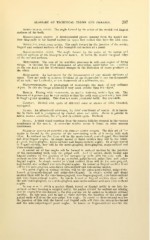Page 449 - My FlipBook
P. 449
GLOSSAEY OF TECHNICAL TERMS AND PHRASES. 297
Mesio-lingual angle. The angle formed by the union of the mesial and lingual
surfaces of the teeth.
Mesio-lingual groove. A developmental groove running from the mesial sur-
face diagonally to the lingual surface in upper first molars that have the fifth cusp.
Mesio-linguo-occlusal angle. The angle formed by the junction of the mesial,
lingual and occlusal surfaces of the bicuspids and molars at a point.
Mesio-occlusal angle. The angle formed by the union of the mesial and
occlusal surfaces of the bicuspids and molars. It forms the mesial marginal ridge
of the occlusal surfaces.
Metabolism. The sum of the nutritive processes in cells and organs of living
things. It includes the vital phenomena of absorption, assimilation and nutrition
on the one hand and the biochemical changes in the liberation of waste products on
the other.
Micrometer. An instrument for the measurement of very minute divisions of
space. They are made to measure divisions of one thousandth or one ten-thousandth
of an inch ; one hundredth, or one thousandth of a millimeter, etc.
Microphotograph. A photograph of microscopic size made of any ordinary
object. In this the image produced is very much smaller than the object.
Mobile. Having wide movements, as mobile features, mobile lips, etc. The
features of a person may be very mobile so that the teeth come prominently into view
in laughing and speaking. This does not mean prominent teeth. See Immobile.
Mottled. Marked with spots of different color or shades of color, blotched,
variegated.
Mucin. An albuminoid substance, the chief constituent of mucus. It is insolu-
ble in water and is precipitated by alcohol, alum and acids. Mucin is present in
saliva, mucous secretions, the bile, and in certain cysts. Dorland.
Mucus. A thick viscid secretion from the mucous follicles situated in the mucous
membranes of the mouth. A somewhat similar mucus is found on other mucous
membranes.
Names of angles of cavities and sets of cavity angles. The first set of line
angles is formed by the junction of the surrounding walls of a cavity with each
other. In occlusal cavities these will be the mesio-buccal, mesio-lingual, disto-buccal
and disto-lingual angles. In simple mesial or distal cavities they will be the bucco-
gingival, linguo-gingival, bueco-ocelusal and linguo-ocelusal angles. In simple buccal
or lingual cavities, they will be the mesio-gingival, disto-gingival, mesio-occlusal and
disto-occlusal angles.
A second set of line angles will be formed in occlusal cavities by the junction
of the surrounding walls with the pulpal wall. And in mesial, distal, buccal and
lingual cavities by the junction of the surrounding walls with the axial wall. In
occlusal cavities these will be the pulpo-mesial, pulpo-buccal, pulpo-distal and pulpo-
lingual angles. In simple mesial or distal cavities these will be the axio-gingival,
axio-buccal, axio-occlusal and axio-lingual angles. In buccal or lingual cavities these
will be the axio-gingival, axio-distal, axio-occlusal and axio-mesial angles.
The point angles in occlusal cavities will be the pulpo-mesio-buceal, pulpo-disto-
. buccal, pulpo-mesio-lingual and pulpo-disto-lingual. In simple mesial and distal
cavities these will be the axio-bucco-gingival, axio-linguo-gingival, axio-bucco-occlusal
and axio-linguo-ocelusal angles. In simple buccal or lingual cavities these will be
the axio-mesio-gingival, axio-disto-gingival, axio-mesio-occlusal and axio-disto-ocelusal
angles.
In any case in which a mesial, distal, buccal or lingual cavity is cut into the
occlusal surface forming a complex cavity, the angles toward the occlusal are missing
and the angles that are formed in the step portion will be named as in simple occlusal
cavities. In this case, and in any of these cavities, the junction of the axial and
pulpal walls will form the axio-pulpal line angle. In mesio- or disto-occlusal cavities
the junction of this with the buccal and lingual walls will form the axio-pulpo-buccal
and the axio-pulpo-lingual point angles. In bucco- or linguo-ocelusal cavities the


